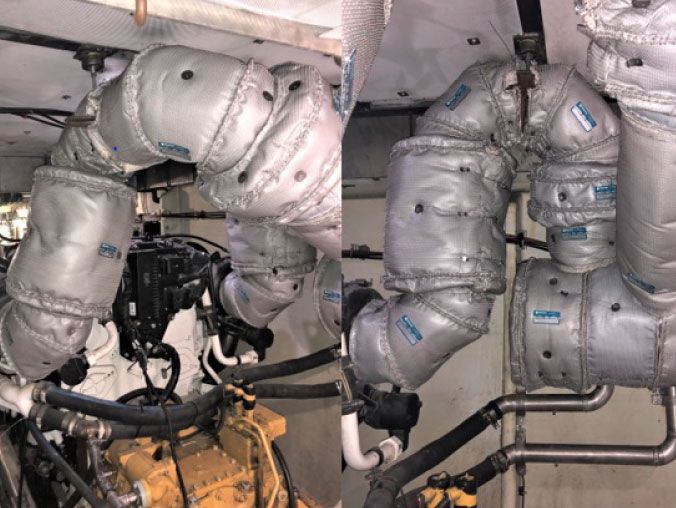Complicating the modernization program for the boats was the fact that the work to install the generators and piping was lasting longer than anyone anticipated. As the boat owners saw the beginning of the tour season bearing down on them, they were in a time crunch not only to finish the installation of the generators, mufflers and piping but also insulate the new generation systems.
The history and design of removable, reusable insulation
The concept for a flexible and removable, reusable insulation system, which is self-contained, comes from the maritime industry. The Maine Maritime Museum in Bath, Maine, includes a fishing schooner modified from sail to engine power in the 1930s. The vessel has some of the earliest examples of insulation blankets for engine exhausts. This historic schooner is proof the marine industry has long embraced the benefits of removable, reusable insulation. In fact, if a careful observer were to visit the schooner, he or she would immediately see the fundamental purpose and unique advantage of reusable insulation versus conventional insulation materials that are removable but not something a mechanic can put back on an application.
For high-temperature applications such as engine manifolds, mufflers and exhaust piping, there’s no equal to well-designed removable and reusable thermal/acoustic blankets. But what goes into making well-designed insulation that marine mechanics can easily remove from and put back on the intended application again and again? Making reusable blankets for manifolds, engine exhausts, and many other marine components requires designs that adhere to specifications and tests like ASTM and UL. Designing to exacting standards and specifications involves experts who’ve mastered the use of computer-aided design and a CNC manufacturing process. By relying on CAD/CNC methods and processes, a blanket insulation maker can ensure its solutions are the kind that crew members can quickly remove and replace while underway.
Blanket insulation for the marine industry must also adhere to specifications that guarantee the product resists chemicals and weather and retains radiant heat up to 1,100 F (593 C) if necessary. For example, Shannon Thermal Blankets meet testing standard ASTM C335. And Shannon’s Acoustic Blankets meet test standards ASTM-E1222 and ISO-15665, while reducing sound by 4 to 10 dBA.
The benefits of removable, reusable marine insulation are:
- greater engine efficiency,
- less emissions,
- lower surface temperature (i.e., OSHA compliance and lower insurance rates), and
- reduced ambient temperature.
When a manufacturer designs thermal blanket insulation specifically for the application and tests the product to stand up to extreme conditions like heat and vibration, marine crews gain all the benefits mentioned above.
After Shannon delivered its blankets to the Maid of the Mist team on time and on budget, the company’s chief marine engineer said, “Shannon’s standards and specifications assured us that a quality insulation system and better engine efficiency would be what we got for our money.”
Specific features to look for in a truly reusable blanket system include:
- Integral fasteners for an easy-on, easy-off process,
- Double-sewn blanket construction to retain shape and hold up to repeated handling,
- Non-porous, high-quality jacketing that holds up under extreme conditions, and
- Designed with a CAD/CNC/ERP and QA/QC approach.
Contact us today if you have questions about the benefits of insulation for marine applications, or would like to know how we can help you with your vessel.

